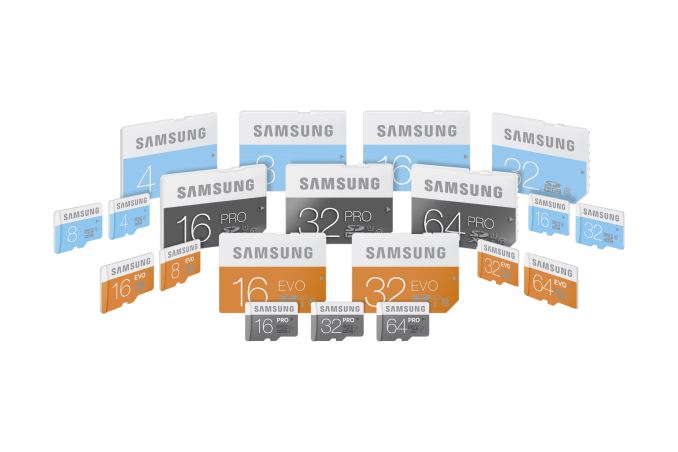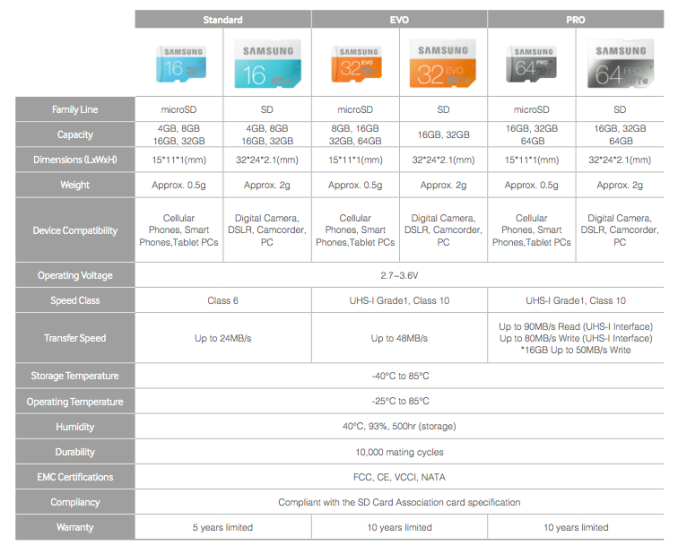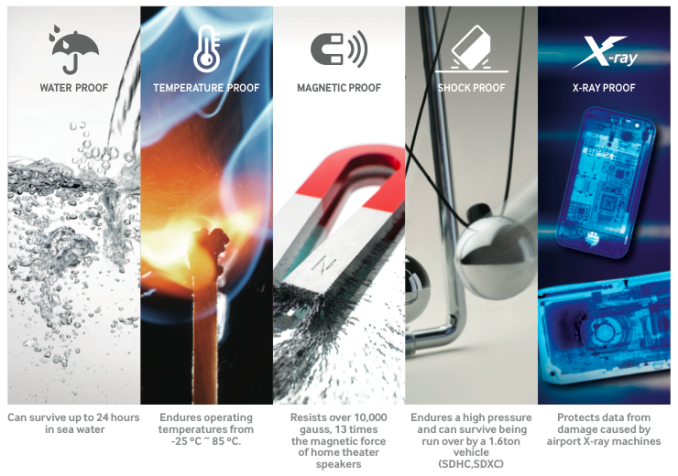Samsung Releases Standard, EVO and PRO SD Cards
by Kristian Vättö on April 7, 2014 10:05 AM EST
With the rapid decrease of NAND prices in the last few years, the SD card market has more or less become a commodity with very little differentiation. We don't typically note minor product releases but we'll make an exception here given that this one is a bit more significant than the average.
Samsung is revamping their whole SD card lineup at once by simplifying it into three product series: Standard, EVO and the PRO. Those who are familiar with Samsung's SSDs notice that the EVO and PRO brands are adopted from the 840 SSD series, which makes sense given Samsung's success in the SSD space and the brand they've been able to build with the 840 EVO and Pro.
Samsung's goal with the branding is to make it as easy as possible for the customer to select an SD card that fits their needs because oftentimes SD cards are marketed using the class system (like class 10), which may not tell much to an average SD card shopper. Electronics stores tend to have isles of SD cards available and differentiating in that space is extremely hard, so Samsung hopes that its simple branding will help to boost sales. Each brand also has a unique color (turquoise for Standard, orange for EVO and black for PRO) that aims to simplify branding even further and to allure customers (we all like vibrant colors, don't we?).

At the low level these are all MLC NAND designs but with varying quality of NAND being used. In fact only a small portion of the NAND meets the requirements for SSDs, the rest of the NAND is used in products where endurance and performance aren't as critical (such as USB drives, SD cards, eMMC...).
Update: As some of you speculated in the comments, the Standard and EVO models do in fact use TLC NAND, while MLC NAND is only used in the PRO model. The info we got from Samsung during the initial briefing was incorrect and we apologize for the confusion.
All in all, the SD card market as a whole is quite uninteresting. When you can get a decent SD card for a tenner or two, it's logical that not much time is spent on the purchase decision or research. Simple branding can help with that and the high-end niche for the PRO model does exist, but I still believe that the average buyer will just get the cheapest card available or the one that is recommended by the sales rep.











46 Comments
View All Comments
shadowjk - Tuesday, April 8, 2014 - link
Generally speaking, older cards around 2008-2009 era were faster in terms of IOPS thanks to their smaller erase block size, and slower in sequential due to having slower nand. The class2 cards had better IOPS than class 6, because in the class 6 they striped multiple nand dies together for sequential write speed boost, but at the same time effective trippled the erase block size.Today, there are a few cards that are "quick", compared to the typical 1 IOPS of most cards. Yes, that's 1, one, without the k expected from ssd.
Personally I've found Sandisk Extreme MicroSDHC, the 45M/s version (the 90M/s is again a magnitude slower at random) fast, Samsung Pro MicroSDHC (the old one before this announcement), and A-data ultra high speed microsdhc. The latter is actually advertised as having higher iops and will benefit apps-on-sd usecase. A-data card is the fastest in terms of iops that I've found so far, however it's pretty fragile, things like an unexpected powerloss, reboot, or card eject will completely and utterly throw your data into a random disarray, though the card itself continues working as before if you give it new filesystem.
Sandisk Ultra Android edition deserves a special mention, while it's not in the same magnitude class as the above 3, it's a less expensive option that doesn't entirely fall flat on its face if you do any kind of non-sequential access.
Be careful with benchmarking too, any of the aboive (and most likely also other cards based on the same platform) have a tendency to reach their steady-state performance approximately after 1.2 crystalbenchmark runs with default settings.
They also effectively fix their perfirmance if you throw a few gigs of sequential writes at them, which is handy, as benchmark software tend to do that at the very start. After heavy random i/o the cards also run slower in sequential mode until they get themselves sorted internally.
The difference between burst mode and steady state performance varies, but somewhere around factor 10-1000 difference. But hey, if a regular card does 1 iops, a fancy card does 300 iops "fresh" and 15 iops steady-state, that's still 1500% improvement!
Kingston got bad rep for switch-and-bait with their SSD, and comments on here appeared shocked and surprised that kingston didn't learn from OCZ. I was not at all surprised at this, as it's something they do consistently and repeatedly with their SD cards. They can be tosh nand with kingston controller (which is utter garbage), samsung nand with toshiba controller, or any other combination of known and unknown controllers and nand.. They will also buy ghost shift SDs, complete with incorrect reproduction of their own logo on the card, put them in real kingston retail packaging, and push it through their retail channels.
It's hard to review cards, as even reputable companies like Sandisk will use the same branding for different products. Luckily they do change SKUs when the product changes, however they also have different SKU/product number for the same product sold in a different packaging, through different channels, or in different countries. The "Sandisk Ultra MicroSDHC" has gone through about 9 generations of technology by now, and a few hundred SKUs. The previous gen has performance properties nothing like the current one, but it's easy to buy either, as they are still both being sold, though under different sku.
Kingston as mentioned before, is a pure lottery. Not saying you can't buy a good kingston card, just that you have absolutely no idea what you'll get.
Transcend and Integral have some limited marketing material available for "Industrial" cards. One major selling point is "BOM Control", I take it to mean that you can pay them extra and they promise that every card of your order made on that day, will be made from the same components.
When "It's not made out of random crap collected from street vendors in Shenzen" has become a marketable selling point, you know the SD card market is a total chaotic wild wild west.
SD Boring? Hardly. Almost impossible to sanely review? Yes. You'd probably have to more or less ignore the vendors without their own fab, I guess that leaves you samsung and sandisk/toshiba. Maybe this is why so few sites attempt it, and even fewer sites do it in a manner anywhere near approaching a proper review.
mthink - Wednesday, April 9, 2014 - link
samsung galaxy s5 Negative Direction Wrapped Edge technologyM-think Technology specializes in Leather injection for cases and accessories for mobile handsets and digits.
mthink - Wednesday, April 9, 2014 - link
ABOUT USM-think Technology specializes in Leather injection for cases and accessories for mobile handsets and digits.
M-think Technology is a joint venture company with SZTIM and was established in 2005. Our head office is located in Shenzhen, China. M-Think Technology is a company that is passionate about its clients and the products that it manufactures. We take pride in offering unique, quality products, at an affordable price.
Some Varieties that we manufacture phone made with below injection technology.
1.leather injection
2.textile fibres injection
3.Carbon Fiber Injection
4.Full-Wrapped Edge leather Injection
5.Negative Direction Wrapped Edge technology
WHAT’S LEATHER INJECTION?
Leather injection injects the TPU, PC,ABS with Leather with the help of a machine under the proper temperature and speed control. Not with glue, thus not only making the cases more durable, but also have a nice and rich texture with no bad smell.
At M-Think Technology co ltd we specialize in researching, designing, developing, producing
and selling cases of all types. Products that we specialize in are Protective Cases, such as Shockproof Cases,
Waterproof Cases, Carbon Fiber Battery Cover, Kickstand Cases , Armor protector & Phone Housings.
United provides ODM/OEM service, Printing LOGO service as well to meet customer`s requirements
The brands we primarily focus on for Leather injection for is Apple, Samsung, Blackberry, Sony, Disney & any other major brands. The main products are apply to phone,earphone,bluetooth,camera and other digits.
Generally, We are leading in Use below material to make accessories
1. TPU
2. PC
3. Leather
4. PC+TPU
5. Silicon
6. Carbon fiber
7. Cloth Fabric
mthink - Wednesday, April 9, 2014 - link
goodMorawka - Wednesday, April 16, 2014 - link
Where can we buy ? these still arent on NewEgg.com 3 weeks later after releasertraister - Friday, January 1, 2016 - link
i purchased a samsung 32 EVO card in Singapore a few months ago. It has gone bad and I am unable to reformat it or do anoythng with it. I am not in Thailand so obviousliy I can not return the card to singaport. I am not impressed with the quality of samsung prodiucts these days they seem to be slipping compared to quality in past years. I am thinking of changing from Samsun Note 4 to the Apple. seems like a good move given all the problems with Samsung and the Android/ Google system.